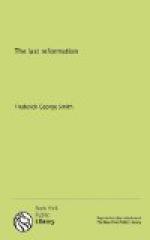The resurrection of the witnesses doubtless signifies a time of reformation and implies its true character. If the death of the witnesses was the result of ecclesiasticism and false teaching, their resurrection must signify a final triumph over ecclesiasticism and the restoration of primitive Christianity under the direct authority and government of God. Even omitting all details in this complex description, we can scarcely avoid the conclusion that if the general description given in this chapter means anything, it means the restoration of Christianity before the end of time to the condition in which it existed before the apostasy.
[Sidenote: The time prophecy]
The time prophecy “three days and a half” is difficult to explain except in the light of clearly ascertained historical facts. The term “day” is of itself very indefinite, being used in the Scriptures to designate periods of different length. In the description under consideration it evidently can not signify the ordinary 24-hour day nor yet the year-day; for it covers the Protestant period following the 1,260-year reign of Romanism and preceding the Last Reformation—the same period of time covered by the second beast of Revelation 13.
The events of the Protestant period naturally divide it into shorter epochs of about a century each in length. The historian D’Aubigne, who wrote about 1835, noticed this distinction and referred to it in his famous History of the Reformation. These are his words: “It has been said that the three last centuries, the sixteenth, the seventeenth, and the eighteenth may be conceived as an immense battle of three days’ duration. We willingly adopt this beautiful comparison ... the first day was the battle of God, the second the battle of the priest, the third the battle of Reason. What will be the fourth? In our opinion the confused strife, the deadly contest of all these powers together TO END IN THE VICTORY OF HIM TO WHOM TRIUMPH BELONGS.”—Book XI, Chap. 9.
“Three days and a half,” or three hundred and fifty years, after the formation of the first Protestant creed, in 1530, God began to reveal special light and truth on his Word and to cause a great awakening, which is gradually resulting in the rejection of human ecclesiastical rule, the recognition of the primitive government of God, and the restoration of all the pure truths of the Word of God.
Another point in the prophecy under consideration assists us in fixing the chronology of the reformation predicted. The “great earthquake” stands closely associated with the time of the resurrection and exaltation of the witnesses. The principles of interpreting symbols would lead us to identify this earthquake as a mighty political convulsion destructive in its nature, and yet one that would be overruled for the furtherance of Christ’s kingdom—a convulsion that would also terminate the destructive reign of the “second woe.” I can




